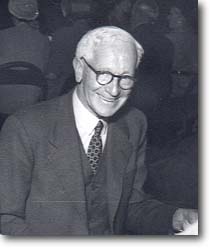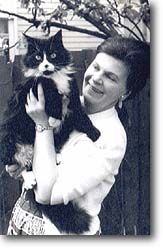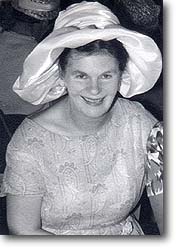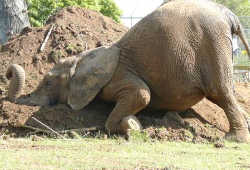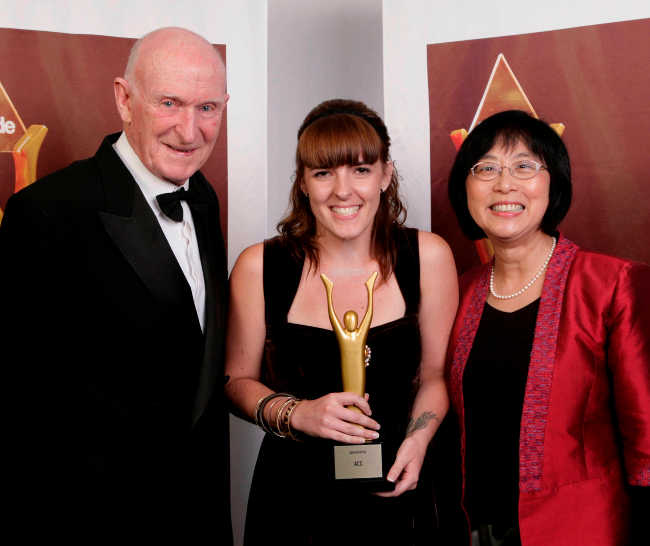Dorothy – 25/05/01
Thousands of New Zealand children were Leaguers in Hays Junior League run by Aunt Haysl.
Who was Aunt Haysl? ‘Aunt Haysl’ was the role which James Hay of Hays Ltd designated for a person to organise a club to attract families to the store known as Hay’s – the Friendly Store. Edna Neville held the position for thirty seven years and became identified with the role in the minds of many thousands of New Zealanders and their penfriends abroad.
Hay’s Ltd – founded 1929 James Hay, known to his friends as Jim Hay, worked as advertising manager for Ballantynes, but then decided to open his own business aimed at a different market and operating in a different style from Ballantynes which followed conservative marketing methods and served a well-established clientele of the more prosperous Christchurch citizens.
|
|
| Jim Hay – later Sir James Hay |
James Hay obtained the financial backing of an Auckland businessman, and on Friday, 13 December, 1929, opened a store with a staff of twenty nine in the less fashionable part of the city north of Cathedral Square, away from the established stores in Cashel Street.
Those who were superstitious must have thought that the inauspicious date was living up to its reputation when the Great Depression hit New Zealand a few months after the store opened, but the business survived the Depression and went on to prosper for the next fifty three years. Most people simply stopped purchasing, but were attracted to this new store because it had novelty features. ‘No Frills’ marketing was a relatively new concept. All products had to be paid for in cash, and self service was introduced with goods on display for customers to browse without any pressure on them to purchase. Customers received coupons for their purchases and these could be cashed for extra value during the firm’s birthday celebrations each year.
Staff valued and given a sense of being in a team For the staff it was an interesting place to work. Jim and Moya Delore met at Hay’s when they both worked there. Moya worked in the mantles, and Jim who had trained at the Farmers’ store as a furniture salesman worked in the furniture department. Mr Hay showed a real interest in all the people working in the store. Both Jim and Moya recall the social activities for the staff. Jim served on the Social and Welfare Committee and helped to organise the staff ball. He played in Hay’s football team which competed against other firms for a trophy. He was one of two people who organised a staff cricket team and entered the team in the Christchurch Suburban Cricket Association. After winning quite a number of grades they finished up by winning the Junior A competition. Edna Neville played in the firm’s baseball team.
Hay’s League for children Mr Hay had another idea for attracting customers by making the store attractive to children, so he started up ‘Hay’s Junior League’ with ‘Aunt Haysl’ as a person who could be a friend to the children. This was followed by the development of Hay’s Roof as an amusement centre for children, with a miniature train and merry-go-round and holiday activities organised by Aunt Haysl.
The first four Aunt Haysls stayed in the position for a comparatively short time. Edna Neville, one of the original staff members had longed to be Aunt Haysl and was overjoyed to be offered the chance to take over the role in 1944. She was a tremendous success in the position where she stayed until her retirement in 1981.
What sort of life had equipped Edna Neville to fulfil this role so successfully?
Edna Neville tells the story. I did not have an easy life as a child. I was born in 1912 and lived in Opawa and then in Hornby with my mother and sister as my father was first away serving in the army in World War 1, and then working as a musterer on a station near Hanmer Springs. Sometimes my sister and I would stay with an aunt while my mother caught the bus to Hanmer Springs to see my father.
I well remember the sad time of the influenza epidemic in 1918. I recall vividly being taken into a tram which was used for fumigation.
Money was not plentiful. We girls would have only one pair of shoes and would try to keep them clean and dry, but this was difficult as at Hornby the roads were not sealed, the footpaths were narrow and water races ran beside the roads. We had few clothes and had to take care of them. Once when I was eleven my father bought me a pink velvet suit and a picture hat and I was ecstatic. I’ve always loved picture hats and wore them in Hay’s Christmas Parades. Being given that outfit was a highlight in my childhood.
My sister and I had few toys and would create our own games. I loved sport at school and was captain of the basketball team. I loved trees, birds and animals and greatly valued bird and animal books I was given. When I grew up I always had cats as pets, fed stray cats and raised money for the Cats Protection League by selling books of my poems.
|
|
| Edna Neville/Aunt Haysl with one of her cats |
When I passed the Proficiency examination in Standard six I went to the Christchurch Technical School. My uniform was a navy gym frock and blazer, a white blouse, and black lisle or woollen stockings. I loved English lessons and would have liked to become a journalist. I took a correspondence course in journalism. I also studied book keeping, typing, geography, and history. When I left school my mother made my gym frock into a skirt for me to wear to work – an example of our frugal lifestyle.
Treats were rare and greatly valued. When I was fifteen there was a school trip to the Dunedin exhibition and the family saved up the money for me to go. It was an unforgettable experience. I especially enjoyed the train trip and the company of lovely people in the group.
Looking for a job I applied for holiday work in the new store, Hay’s Ltd. I had good school reports and belonged to the Presbyterian Church and Bible Class. Mr Hay, who had been deeply involved in the youth work of the Presbyterian Church, wanted all his staff to be Presbyterians. I remember that we were trusted in the handling of cash which was never checked by another staff member. I was given holiday work and then offered a permanent job.
Once on the staff of Hay’s Ltd I began to live. I was employed in many roles – as a corset fitter, hand embroidering monograms on school blazers, smocking dresses, repairing ladders in lisle or silk hosiery, and selling toys, haberdashery, millinery, and women’s fashion garments.
One Saturday I was sent by train to Lyttelton to judge a competition for a May Day Queen. I did this for several more years and later as Aunt Haysl every year I judged some thirty five children’s competitions – fancy dresses or decorated bicycles.
During the Depression years there were cuts in wages but the staff worked as a team to ensure the survival of the firm.
In 1940 I was crossing the road and was hit by a car, and was seriously injured. I was in hospital for three weeks and had little money in the bank to pay my medical expenses, but Hay’s Ltd paid these for me.
During the war I trained as a VAD (Voluntary Aid Division). This involved doing a course in home nursing, hygiene and sanitation and sixty hours practical work at the hospital – outside work hours.
I was always interested in working with children. In 1944 I was offered a position as matron of St Saviour’s Orphanage. While I was thinking about whether to change my job I was offered the position of Aunt Haysl, accepted and remained as Aunt Haysl until my retirement in 1981.
Mr Hay offered me generous inspiration for my work. The aim was to bring to the children education and amusement. The journalism training proved valuable as I produced a magazine called Hay’s Junior Leaguer every month with my editorial, stories, competitions and original work sent in by Leaguers. I advertised anything that was happening in the city. I saw to it that Leaguers were distributed in nearly every school, and I gave them to children wherever I went, in buses or at fairs or entertainments.
One early activity was the building of a huge fireplace on the Roof and children gathered there every Friday night to eat bread and saveloys and drink billy tea from water boiled on the fire.
To equip myself better for the job I undertook any training that I thought would be useful. A number of the children who came to talk or wrote to me were stressed and lonely. Having not had an easy childhood I could often identify with their feelings. To understand them better I studied psychology at the Workers Education Association and attended their summer schools. Because of my interest in children I worked for Cholmondeley Children’s Home, Dr Barnados and the Save the Children Fund.
The role involved speaking in public and on the radio so I studied speech and drama under Enid Frye and gained my ATCL. For thirteen years I conducted radio sessions on 3ZB with music, news and Uncle Ben’s stories. I have given items at thousands of gatherings for young and old all around the South Island reciting both serious and humorous pieces. I have worked for fifty years for the Canterbury Repertory Society, taking part in many plays and organising front of house volunteers.
Hay’s League Junior Choir offered musical training under A. G. Thompson and later Clifton Cook to a hundred children aged seven to thirteen, selected from three hundred applicants. Two concerts raised enough money to buy uniforms for the choir – gym frocks and blouses for the girls, grey shorts and white shirts for the boys. They gave items at special functions and formed a concert party with local artists.
I wrote 675 letters in my first week as Aunt Haysl and have written many thousands of letters since and at one time organised a penfriend service for the Leaguers to develop friendships throughout the world.
I developed a library of two thousand books on a wide range of subjects and made them available free to the children.
Every year for Hay’s Christmas Parade which began in 1948 I wore a new dress and a picture hat. I had my own float and chose Leaguers to be dressed as fairies and accompany me.
|
|
| Edna Neville/Aunt Haysl in a picture hat |
To enrich my knowledge of what was happening in the world I worked for the Navy League and joined the Commonwealth Association and the Travel Club. My horizons were further widened by a trip to Japan as the New Zealand delegate to a peace conference with delegates from countries worldwide.
In 1966 I became a foundation member of the Christchurch Branch of the service club Altrusa. I still attend the meetings and when I need help the Altrusa members are the first to give me support. The club has set up the Edna Neville playground at the Christchurch Women’s Hospital to provide a place for children to play safely while their parents are either in hospital as patients or visiting.
When I retired in 1981 Hay’s set up the Aunt Haysl Trust. Money was donated by the store, other businesses and friends. Since then $200,000 has been given to voluntary organisations in Christchurch.
British Empire Medal In recognition of Edna Neville’s community work she was awarded the British Empire Medal in 1970. The investiture was conducted by Her Majesty, Queen Elizabeth II, on Friday, 13 March 1970. (So much for superstitions about Friday 13!)
Edna continues to be well known in Christchurch. In the last two days I have had three comments from people who knew her as Aunt Haysl in different eras. Mary Rene remembers the Christmas parades and her excitement when the float with Aunt Haysl came by. “In her picture hat I thought she looked just like the Queen Mother.” Kathy remembers her excitement about being a fairy on Aunt Haysl’s float. Wendy described being taken up to Hay’s Roof as like entering “a magic wonderland”.
To go out in public anywhere with Edna is like being an escort on a celebrity’s walkabout. She is constantly being greeted with warm recognition by friends, former Leaguers and members of community organisations in which she has been involved.

